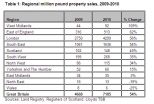(Press-News.org) The U.S. Geological Survey assessment on the economic recoverability of undiscovered, conventional oil and gas resources within the National Petroleum Reserve in Alaska (NPRA) and adjacent state waters is now available.
This economic analysis is based on a 2010 USGS resource assessment (http://pubs.usgs.gov/fs/2010/3102/) that determined how much undiscovered, conventional oil and gas in the NPRA is technically recoverable. These reports provide updates from the USGS 2003 economic analysis (http://pubs.usgs.gov/of/2003/of03-044/) and 2002 resource assessment (http://pubs.usgs.gov/fs/2002/fs045-02/) of the NPRA.
"The USGS conducts assessment updates to re-evaluate petroleum potential as new data and information become available," said USGS Energy Resources Program Coordinator Brenda Pierce. "Understanding how much undiscovered, technically recoverable resource might be present serves as a basis for calculating how much might be economically developed."
Technically recoverable resources are those that could be potentially produced using current technology and industry practices. Economically recoverable resources are those that can be sold at a price that covers the costs of discovery, development, production and transportation to the market.
The new economic analysis estimates that approximately 273 million barrels of undiscovered oil are economically recoverable at an oil price of $72 per barrel (comparable to $8 per thousand cubic feet of gas). About 500 million barrels of undiscovered oil are economically recoverable at $90 per barrel (comparable to $10 per thousand cubic feet of gas). These estimates do not include the discovered oil accumulations in northeastern NPRA that have not yet been developed.
The economically recoverable oil estimates above are dependent upon gas exploration in the NPRA, meaning that it is assumed the oil would be found in the process of looking primarily for gas.
The USGS assessment also found that about 18 trillion cubic feet of undiscovered gas are economically recoverable when the market price is $8 or more per thousand cubic feet, and 32 trillion cubic feet of undiscovered gas would be economic when the market price is $10 or more per thousand cubic feet.
There currently is no pipeline in place to transport gas from the North Slope of Alaska, so this assessment assumes that there is a 10- or 20-year delay between discovery and production in the NPRA. This analysis shows that if a pipeline is constructed, there is a significant amount of gas that is economically recoverable from the NPRA when prices are above $8 per thousand cubic feet of gas.
The different market prices quoted above for the same resource are because some resource accumulations are relatively easy to find and produce while others are not and therefore cost more.
"USGS estimates are based on 2010 costs and technology, and these results could change over time as they are dependent on multiple factors," said USGS scientist Emil Attanasi, who was the lead author for this assessment. "For example, USGS economic recoverability estimates could vary in the future depending on the timeframe and costs to construct a gas pipeline to the NPRA, technological advances that make resource extraction and development easier and less expensive, and fluctuating market prices for oil and gas."
The amount of oil that could be economically developed is significantly less than what the 2003 analysis concluded. One reason for the reduction is reduced volumes of technically recoverable oil based on recent NPRA exploration drilling which found gas rather than oil.
All of the cited resource estimates are based on the mean undiscovered resources.
###
Listen to a podcast interview with USGS scientists on this assessment at http://gallery.usgs.gov/audios/404.
To learn more about this or the geologic assessment, please visit the Energy Resources Program website at http://energy.usgs.gov/alaska/npra.html.
USGS economic analysis updated for the National Petroleum Reserve in Alaska
2011-05-05
ELSE PRESS RELEASES FROM THIS DATE:
Hitting target in cancer fight now easier with new nanoparticle platform, UCLA scientists say
2011-05-05
The ability to use nanoparticles to deliver payloads of cancer-fighting drugs to tumors in the body could herald a fundamental change in chemotherapy treatment. But scientists are still at a relatively early stage in the implementation of this technology.
Although developing nanoparticles that work as "magic bullets" — selectively targeting tumors while sparing normal, healthy tissues — is still the goal, the reality is that most of these nanocarriers are removed through the liver and spleen before ever reaching their intended target. And many of the encapsulated drugs ...
Estimated costs of environmental disease in children at $76.6 billion per year
2011-05-05
In three new studies published in the May issue of the journal Health Affairs, Mount Sinai School of Medicine researchers reveal the staggering economic impact of toxic chemicals and air pollutants in the environment, and propose new legislation to mandate testing of new chemicals and also those already on the market.
Leonardo Trasande, MD, Associate Professor of Preventive Medicine and Pediatrics at Mount Sinai School of Medicine, analyzed the costs of conditions – including lead poisoning, childhood cancer, asthma, autism, and attention deficit hyperactivity disorder ...
Newly discovered plant fossil reveals more than age
2011-05-05
Over 100 million years ago, the understory of late Mesozoic forests was dominated by a diverse group of plants of the class Equisetopsida. Today, only one genus from this group, Equisetum (also known as horsetail or scouring rush), exists—and it is a prime candidate for being the oldest extant genus of land plant.
There is some debate as to the evolutionary beginnings of the genus Equisetum. Molecular dating places the divergence of the 15 extant species of the genus around 65 million years ago (mya), yet the fossil record suggests that it occurred earlier than that, ...
New algorithm significantly improves imaging for full-body MRIs
2011-05-05
A new study reveals an improved algorithm that can dramatically improve how radiologists capture and interpret full-body MRIs, particularly in the abdominal region.
Motion artifacts in MRIs, such as patient movement, often appear as ghosting artifacts which may obscure clinical information says Dr. Candice Bookwalter, presenting author for the study. "Almost every acquisition during an MR abdominal exam requires a breath hold to limit motion. For example, a routine liver exam includes at least nine breath holds. Even with fast imaging techniques, these breath holds are ...
AllTernative Gym Transforms the Lives of Those With Special Needs
2011-05-05
AllTernative Gym is transforming lives with its state-of-the-art fitness and therapy programs developed specifically for those with special needs. Founded by Certified Fitness Trainer and Expert, Angie Gomez, AllTernative Gym provides Adeli Suit Therapy, Fitness Training and Hyperbaric Oxygen Therapy.
"As a parent of a child with special needs, I truly understand what parents are looking for in a therapy center. And, I treat each child as if he were my own and each adult as if they were a family member," states Angie Gomez, founder of AllTernative Gym. Angie ...
Sonography complements physical exam in identifying juvenile inflammatory arthritis in children
2011-05-05
Juvenile Inflammatory Arthritis (JIA) is a potentially debilitating childhood disease. Early detection and treatment of active arthritis may avert long term joint damage and disability. Research has shown that sonography with power Doppler can facilitate making assessments in joint activity and sub-clinical disease, according to research being presented at the 2011 American Roentgen Ray Society's annual meeting.
The study, performed at Albert Einstein College of Medicine's Montefiore Medical Center, in Bronx, NY, compares sonography with power Doppler to physical examination ...
Ultrasound combined with pre-operative MRI is cost effective in evaluating rotator cuff tears
2011-05-05
While ultrasound is usually viewed as more cost effective, MRI is most often used to evaluate the rotator cuff. When performing a cost utility analysis, utilizing an ultrasound as the initial imaging test for rotator cuff tear, along with pre-operative MRI to identify alternative and concurrent diagnoses, can be a very effective hybrid imaging strategy, according to research being presented at the 2011 American Roentgen Ray Society's annual meeting.
The study, performed at Duke University Medical Center in Durham, NC and Rush University Medical Center in Chicago, IL, ...
Million Pound Home Sales Rise at Fastest Rate Since 2006
2011-05-05
The number of million pound property sales in 2010 increased at the fastest rate for four years, according to research by Lloyds TSB. There were 7,185 million pound property sales in Great Britain in 2010: 54% higher than in 2009. This is the largest annual increase since 2006 (62%) and suggests a real resurgence at the very top end of the mortgage market. In total, there are now an estimated 184,0001 homes in Britain worth at least one million pounds.
Despite this significant increase, million pound property sales remain 13% below the levels they reached before the ...
Racial disparities still exist in colorectal cancer screening despite increased Medicare coverage
2011-05-05
PHILADELPHIA — Despite expanded Medicare coverage for colorectal cancer screening tests, lower rates still exist among blacks and Hispanics compared to other ethnic groups, according to research published in Cancer, Epidemiology, Biomarkers & Prevention, a journal of the American Association for Cancer Research.
Researchers from the University of Texas School of Public Health used data from the Surveillance Epidemiology and End Results Program (SEER), a National Cancer Institute database, to determine the prevalence of colorectal cancer screenings among Medicare beneficiaries ...
Study suggests prolonged bottle feeding increases the risk of obesity
2011-05-05
Cincinnati, OH, May 5, 2011 -- Experts agree that obesity prevention should begin before children enter school. But due to a lack of conclusive data, health care providers often have trouble advising parents about which interventions are the most beneficial. A new study soon to be published in The Journal of Pediatrics suggests that limiting prolonged bottle use in children may be an effective way to help prevent obesity.
Dr. Robert Whitaker and Rachel Gooze of the Center for Obesity Research and Education at Temple University, and Dr. Sarah Anderson of The Ohio State ...

